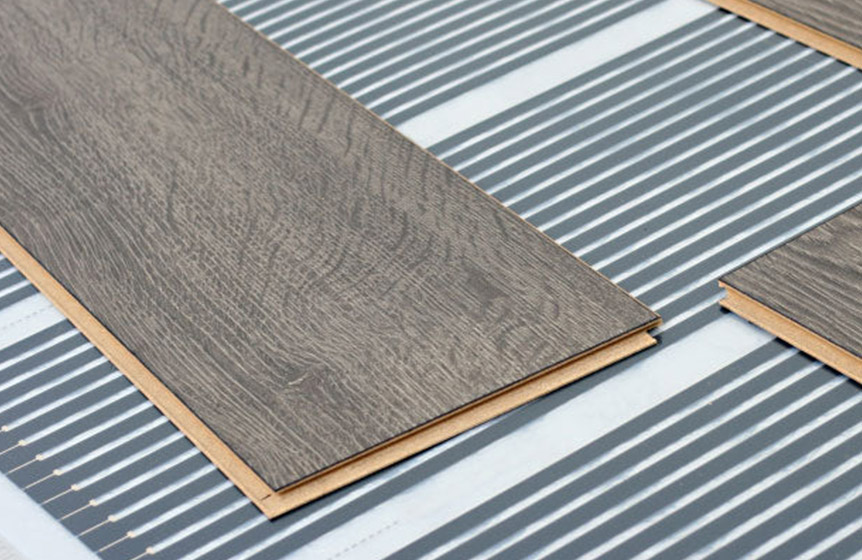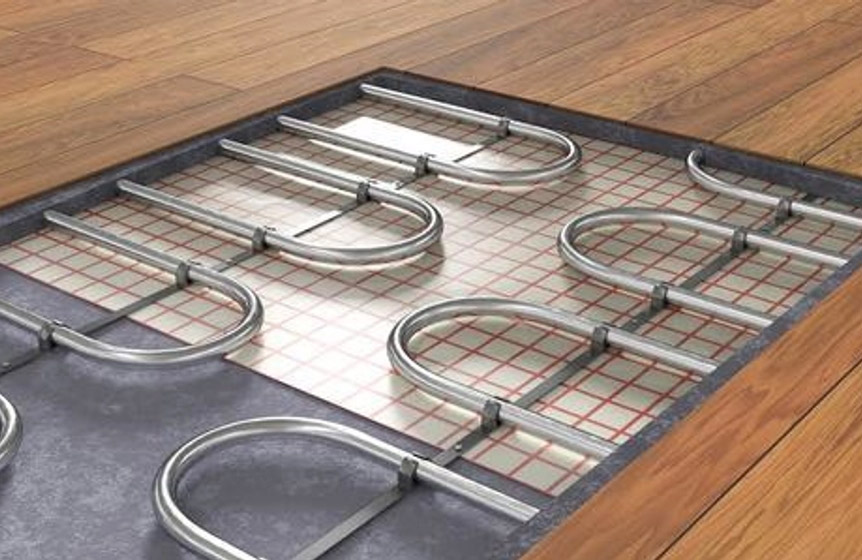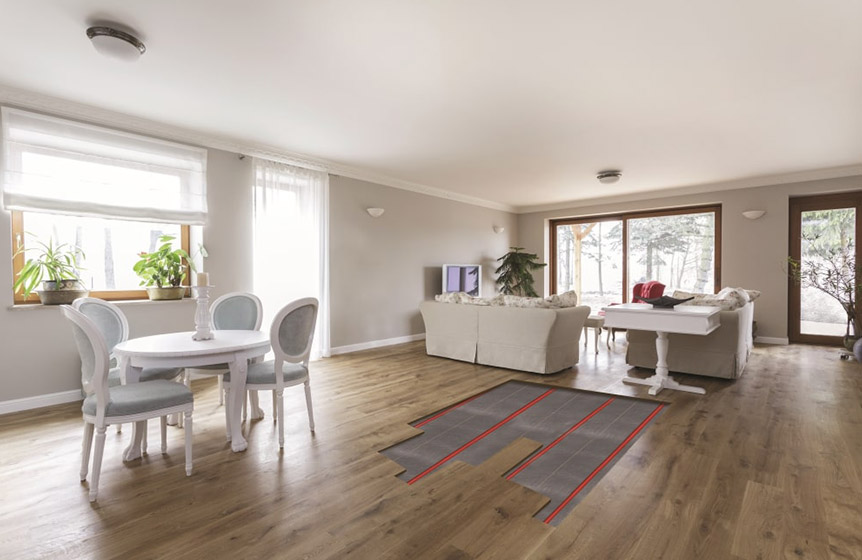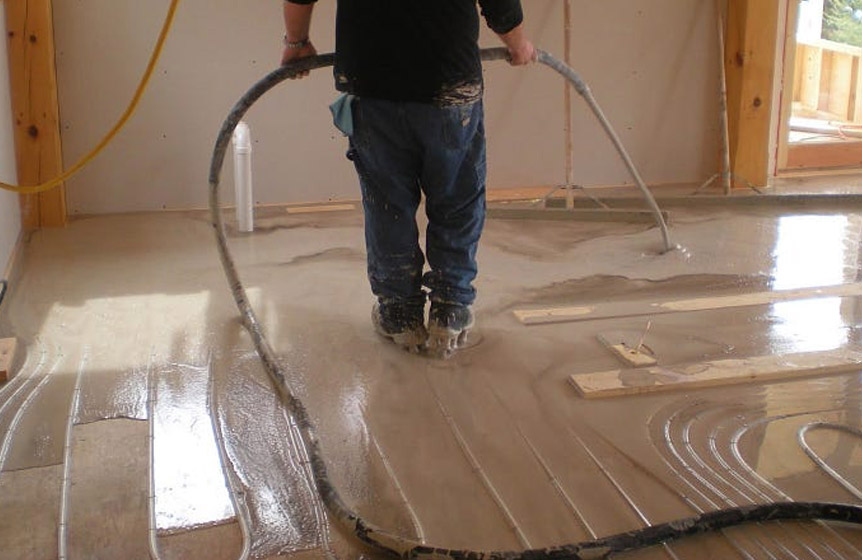In-home design and construction, the marriage of aesthetics and functionality is paramount. One area where this balance is strikingly evident is in the choice of flooring materials and heating systems.
Radiant heating systems have revolutionized how we think about comfort and efficiency in our living spaces. Similarly, engineered wood flooring has emerged as a versatile and durable option, offering both timeless beauty and practicality.
Combining these two elements – engineered wood flooring and radiant heating systems – opens up a realm of possibilities for homeowners seeking the perfect blend of warmth, style, and sustainability.

Table of Contents
ToggleCompatibility of Engineered Wood Flooring with Radiant Heating Systems
Before delving into the benefits of pairing engineered wood flooring with radiant heating, it’s crucial to understand their compatibility. Unlike traditional hardwood flooring, which can be sensitive to fluctuations in temperature and humidity, engineered wood flooring is specifically engineered to withstand such variations.
This makes it an ideal choice for use with radiant heating systems, which operate by circulating warm water through pipes or electrical elements beneath the floor’s surface.
The construction of engineered wood flooring involves layers of wood veneer bonded together with adhesives under high pressure and heat. This composition offers heightened stability and moisture resistance when juxtaposed with solid wood flooring. As a result, engineered wood flooring is less prone to warping, cupping, or cracking when exposed to the controlled heat of radiant floor systems.
Moreover, the thermal conductivity of engineered wood is well-suited to radiant heating, allowing for efficient transfer of heat from the floor to the living space above. This guarantees consistent warmth across the entire room, eradicating any chilly areas and optimizing comfort levels.

Things to note when installing engineered flooring over floor heating
Careful deliberation is necessary when installing engineered flooring over a floor heating system to guarantee peak performance and durability. Here are several key factors to keep in mind:
- Flooring Compatibility: Not all types of engineered wood flooring are suitable for use with radiant heating systems. Verify with the flooring manufacturer to ensure that the flooring is compatible and suitable for installation over radiant heat.
- Subfloor Preparation: Proper preparation of the subfloor is essential for a successful installation. Ensure that the subfloor is clean, flat, and dry before laying the engineered flooring. Any irregularities or moisture issues can affect the performance of both the flooring and the heating system.
- Flooring Installation Method: Choose an appropriate installation method based on the type of engineered flooring and the heating system. Floating, glue-down, or nail-down installations are common options, with floating installations often recommended for radiant heating systems to allow for natural expansion and contraction.
Choose an underlayment explicitly designed for compatibility with radiant heating systems. The underlayment should provide thermal insulation while allowing for heat transfer from the floor to the living space above.
- Temperature Settings: Follow the manufacturer’s guidelines for temperature settings and operating procedures to prevent overheating or damage to the flooring. Avoid abrupt temperature changes, and gradually increase the temperature over time to minimize stress on the flooring materials.
- Avoiding Damage: Exercise caution when installing the flooring to avoid damaging the heating elements or pipes beneath the subfloor. Use care when nailing or stapling the flooring to prevent puncturing the heating system.
- Regular Maintenance: Maintain the radiant heating system and engineered flooring according to the manufacturer’s recommendations. Regular inspection and maintenance help ensure efficient operation and prolong the lifespan of both the flooring and the heating system.
For the best outcome, contemplate engaging a skilled professional installer with experience in both radiant heating systems and engineered flooring. Their expertise ensures proper installation techniques are employed, maximizing performance and durability.

Benefits of Engineered Wood Flooring for Radiant Heating Systems
Enhanced Comfort: One of the primary advantages of radiant heating paired with engineered wood flooring is the unparalleled comfort it provides. Unlike forced-air systems, which can result in uneven heating and drafts, radiant heat rises from the floor, enveloping the room in warmth from the ground up. This gentle, consistent heat promotes a cozy and inviting atmosphere, perfect for chilly mornings or evenings.
Radiant heating systems are celebrated for their energy efficiency, operating at lower temperatures in contrast to conventional heating methods. By utilizing the thermal mass of the floor, radiant heat distributes warmth efficiently, reducing energy consumption and lowering utility bills. Engineered wood flooring further enhances this efficiency by acting as an insulating barrier, helping to retain heat within the living space.
Engineered wood flooring presents a diverse spectrum of design possibilities, spanning from timeless oak and maple to exotic varieties such as acacia and bamboo. With an extensive selection of finishes, textures, and plank sizes, homeowners have the flexibility to tailor their flooring to harmonize with any interior style or decor theme.
The inherent beauty of wood infuses warmth and character into every space, establishing a timeless canvas for furnishings and accents.
Engineered wood flooring is crafted to endure the demands of daily use, rendering it an exceptional option for high-traffic zones like living rooms, kitchens, and entryways. Its multi-layered composition ensures enhanced dimensional stability, mitigating the likelihood of expansion, contraction, or warping caused by fluctuations in temperature and humidity.
This durability ensures that engineered wood flooring maintains its beauty and integrity over time, even when subjected to fluctuating conditions associated with radiant heating systems.
With sustainability becoming an increasingly prevalent concern among homeowners, engineered wood flooring emerges as a more environmentally conscious alternative to traditional hardwood options. By using less solid wood in its construction and incorporating fast-growing species and recycled materials, engineered wood minimizes environmental impact without sacrificing quality or aesthetics.
Additionally, radiant heating systems powered by renewable energy sources further reduce carbon emissions and reliance on fossil fuels, making it a greener heating option for eco-conscious households.
Conclusion
In conclusion, the synergy between engineered wood flooring and radiant heating systems represents a harmonious blend of form and function in modern home design. With their compatibility, versatility, and array of benefits, these two elements come together to create living spaces that are both inviting and efficient.
Whether renovating an existing home or embarking on a new construction project, homeowners can confidently embrace the warmth, beauty, and sustainability of engineered wood flooring paired with radiant heating systems. By harnessing the power of technology and nature, we can elevate the comfort and style of our homes while minimizing our environmental footprint for generations to come.

